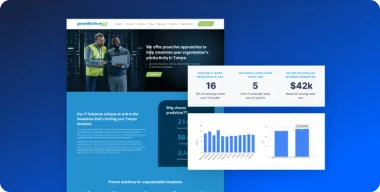With a strong digital strategy, you can get people to come to you, ask you questions, and enter into sales conversations. At the same time, if you fail to take the next step and build a platform that can nurture and support those leads, guiding them through the process carefully, the results won’t be as promising as you had hoped.
This is where the disconnect often occurs. You may even have experienced it either before or after paying for a single a-la-carte service such as social media or paid advertising in Google. Despite claims from whichever marketing firm sold you the service, results are often less than stellar. For B2B campaigns run by manufacturers in particular, success depends on a solid strategy and a multi-pillar foundation of varied tactics. When built properly, you can greatly increase the likelihood that your digital marketing leads transform into sales.
The Three Components of an Effective Strategy
To succeed with a digital marketing campaign, you need a strategy in place: a plan that takes into account your business, the industry, and the people you are trying to reach. We can boil it down to three specific components necessary to ensure the success of your efforts. Let’s take a look at all three.
Component 1 – Persona Targeting and Clear Marketing Strategy
Have you ever thought about how customized your web experience is? When you go to Amazon, Google, Facebook, or a department store website – they know where you are, what you’ve previously purchased, what you search for, who your friends are, and show content differently depending on all those factors and a hundred more.
This level of customization is designed to improve your experience and help you find answers faster. It’s why they are worldwide leaders in their respective online services. Although we can’t hope to replicate the intricacies of Google, we can tap into the idea of targeting our content and marketing strategies to match what we know about our prospects.
Step one of a good strategy is to identify and evaluate the target personas for your services – specific people based on interests, needs, and job position – that you are speaking to. This is where we abandon the broad market language of trade shows and direct mail and focus on the precise problems we know our prospects have. Digital technology makes this not only possible, but much easier to accomplish than ever before. From here, a focused strategy built around the language these people use, the needs they have, and the types of content they are interested in reading or watching come together.
Component 2 – Mechanisms to Capture and Nurture Leads
Once you know who your target audience is – likely a combination of engineers and procurement officers for most manufacturing companies – the next step is to build a machine with which you can capture their information.
This is when you take what you learned about your target prospects’ needs and build a solution. If you know design engineers have a lot of questions about the material selection options for a specific type of stamping you perform, you can produce a downloadable PDF or short video that answers this question. Better yet, because you know how valuable that information will be, you can put a form in front of it and ask them for contact information before they access it.
By identifying the types of content that your ideal prospects are willing to complete a form to access, you can start capturing between 2-3% of your traffic as new leads in your database. This doesn’t have to be a massive, 50-page eBook either. It can be a 2-3-page guide, a checklist for material selection, a resistance guide for certain chemicals, or just a copy of your most recent certifications for documentation purposes. These things have value and will drive new prospects into your funnel.
Once they enter your funnel, your job is to keep them engaged. That’s why lead nurturing is the next step. Using what we know about your prospect’s personas, a lead nurturing track should include emails and additional downloadable content that will help them to resolve more problems and answer more questions. An example would be a link to recent blog posts on your company website followed by a downloadable document with all the information procurement officers might need to work with you as a vendor.
Component 3 – Reliable, Recurring Traffic Source
Once you know who you want on your website and subsequently build the content they are looking for, the last step becomes much easier. This is where you drive new traffic to your website. If you’ve completed steps 1 and 2 properly, this is just a matter of finding those people and getting them to visit your website.
This can be done via social media promotion of your content, organic search optimization, or paid search (if you’re in a hurry). The key is to find a traffic source that is reliable, recurring, and within your marketing budget.
What This Looks Like When Executed Effectively
The reason so many digital marketing campaigns fail is that they skip steps 1 and 2. A company will pay for a brand new website and then start pouring money into traffic generation. After several months, they decide it doesn’t work and stop investing because the ROI is either low or non-existent.
By ensuring steps 1 and 2 are completed before investing in traffic generation – by knowing that you are targeting the right people with the right content – you can vastly improve the effectiveness of your marketing efforts.
More importantly, the people who DO convert and become leads on your website will be of a much higher quality. These will be people who are legitimately interested in what you have to offer, know more about you as a company than they know about your competitors, and trust you because you’ve already provided solutions to some of their early questions or concerns.
That kind of rapport doesn’t grow on trees, and most other websites in your industry will fail to do the same.
Better yet, when built and executed effectively, this kind of lead capture and nurturing system can work largely on autopilot, all the way until someone is ready to speak with a member of your sales team. It’s a powerful and effective way to grow your business using a digital campaign.
Improve Lead Conversion through Proper Execution
If you’ve had less-than-stellar results with online marketing campaigns in the past, or if you just haven’t gotten around to attempting it because of the barriers you’ve seen others struggle against, there is a better way. With proper planning, careful research, and targeted execution, you can capture better leads and convert them at a higher rate using your website.
[scorg_shortcode id=”86113″]






